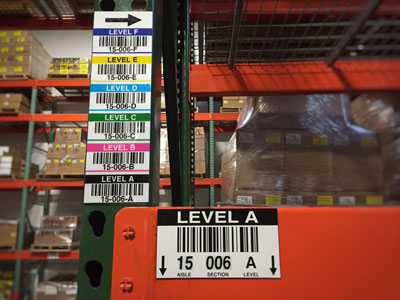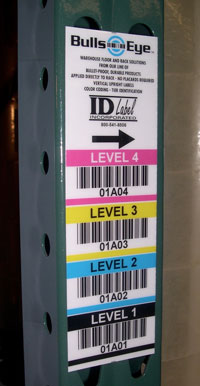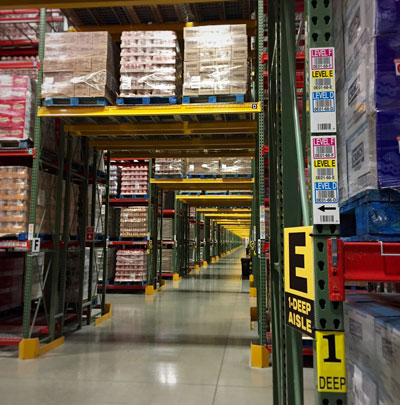Advantages Of Using Barcodes On Vertical Location Warehouse Rack Labels
By Kristen Howard, Business Development Manager, ID Label Inc.
|
complement to vertical labels, color-coded companion labels are used on all rack levels to minimize errors and improve efficiencies |
Introduction
With the continuing expansion of warehouses and distribution centers, driven in part by retail e-commerce growth, the essential role of barcode labels to track and manage inventory is more vital than ever.
In fact, according to a 2016 study from Zebra Technologies, warehouse executives plan to expand the use of barcode scanning by 67 percent over the next five years and cited it as their top area of technology investment.*
In this post, I take a closer look at a specific type of label – vertical location warehouse rack labels – and when it makes sense to deploy them in your facilities.
Advantages of Vertical Rack Labels
Barcode labels are a vital part of an organized and efficiently run modern warehouse. Each label –whether on a pallet, tote or beam – is loaded with a host of product and location information essential to the management and movement of inventory.
For vertical warehouse rack labels, specifically, there are several advantages:
- Eliminates need for long-range scanning and associated errors
- Facilitates man-down, pick-and-scan operations
- Minimizes location confusion and worker errors
- Improves operator scanning accuracy
- When combined with companion location labels, greatly improves accuracy and efficiency
- Enables uniformity across multiple locations for efficient cross-training and consistency
|
BullsEye labels are durable and rigid, made to withstand the knocks and bumps that come with traffic in a typical warehouse |
Let’s explore further.
Man Up or Man Down?
In a multilevel warehouse rack environment, one option is to place location labels on each individual beam horizontally beneath the pallet bay. In this scenario, warehouse operators use cherry pickers or reach forklift trucks to scan labels at each upper-level rack bay location.
This is often referred to as a “man-up” process, as the worker is literally up at the physical location during the scan process.
If you’re not performing man-up scanning at your locations, vertical location labels – which are also called totem labels – are an excellent solution for multilevel warehouse racks. They eliminate the need for long-range scanning, minimize potential confusion and errors, and ensure more efficient operations.
What Information Is Contained in a Vertical Location Label?
A vertical location label is actually a grouping of barcodes that contains specific information for each level of racking within a bay in a particular aisle.
They are often color coded by level. This improves the operator’s scanning accuracy and offers uniformity across their network of distribution centers.
Using the same label format and colors throughout a network of locations can simplify cross-training. It allows warehouse managers the flexibility to shift workers from location to location as needed.
Vertical location labels are typically accompanied by rack location labels – companion labels, in ID Label terminology. These companion labels are used on all rack levels at the physical location for inventory or cycle counts. The companion label is also color coded per level to correspond to the colors used on the vertical label.
Other Uses, Materials
Vertical labels are also ideal for rack tunnel areas where overhead bays are used but access to beams is limited.
For most warehouse applications in ambient temperature settings, we typically recommend a rigid, durable, laminated label that applies easily and is made to withstand the knocks and bumps that come with traffic in a typical warehouse or distribution center (ID Label’s branded product for this application is called “BullsEye”).
|
Vertical labels eliminate the need for long-range scanning, minimize potential confusion and errors, and ensure more efficient operations |
Other options can include vertical magnet labels (for cold storage and freezer environments that are already live, for instance) or even PVC-printed labels that are secured to racking with zip ties.
Conclusion
To sum up, vertical location warehouse barcode labels eliminate the need for long-range scanning, minimize potential confusion and errors, and ensure more efficient operations. Be sure to consider how and where to deploy them when you’re labeling your warehouses and distribution centers.
* “Building the Smarter Warehouse: Warehousing 2020,” Zebra Technologies
---

By Kristen Howard, Business Development Manager, ID Label Inc.
---
Other Barcode news of interest:



